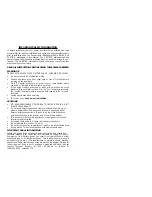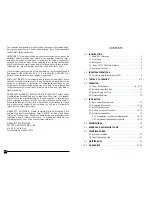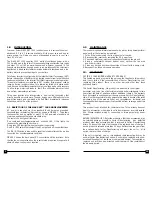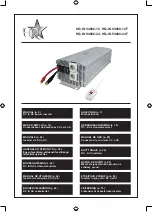
2.0 INVERTER APPLICATIONS
Aside from issues of supplying power to higher wattage appliances,
inverters must be supplied with a constant source of high current12 volt
DC from a bank of batteries. At full 1000 watt load, the DC input require-
ments are up to 100 amperes at 12 volts DC.
Read the following applications and comply with them, and your inverter
will give you years of reliable service.
2.1 UNINTERRUPTIBLE POWER SUPPLY (UPS)
Inverters can be operated as uninterruptible power supplies that continu-
ously provide AC even if outside AC is interrupted. This type of application
continuously operates the inverter from a battery bank, simultaneously
replacing the charge on the battery bank with an AC-powered 12 Volt
battery charger. Charging can also be by means of a solar charger
system.
See FIGURE 3
. The charger must be selected to operate continu-
ously and to be able to fully replace the charge on the battery as the
inverter operates. In this configuration, the battery "floats" on the DC from
the charger, not really supplying power or being charged. When outside
AC fails, the inverter continues to power the appliances for the life of the
useful charge on the battery bank. When outside AC is restored, the
batteries are recharged as the inverter continues to operate. Battery
recharging must be sized to replace the average current supplied by the
inverter plus a little more current. Another requirement is that the battery
charging rate cannot exceed 10% of the rated Ampere Hour (AH) rating
of the battery bank, otherwise the life of the batteries can be dramatically
reduced through overcharging. Most modern battery chargers automati-
cally adjust the charging rate based on the state of charge on the batteries
they are charging. For this type of operation, use deep-cycle batteries and
avoid charging at too fast a rate.
Figure 3
– Uninterruptible Power Supply
UNRELIABLE
EXTERNAL AC
SOURCE
12 VOLT
BATTERY
CHARGER
12 VOLT
BANK OF
BATTERIES
MAXX 1000
POWER
INVERTER
LIGHTS, TV
ETC.
THREE AC
OUTLETS
WARNING:
Never connect the inverter’s AC output to an
AC distribution system.
This procedure is for using locally purchased supplies.
Make appropriate changes to procedure if Vector Cable Set is
purchased .
5.5.2 PERMANENT INSTALLATION PROCEDURES
The cables between the power source and the inverter should be as shown
in
FIGURE 7
. Be sure to remove terminal cover and terminal nuts before
starting permanent installation.
Inverter DC cables and fuse installation is as follows:
1. Using tools and hardware, mount the inverter to the flat surface that
you have selected .
2. Mount the fuse holder to its mounting surface using appropriate hard-
ware. Ensure that the mounting hardware does not touch any of the fuse
holder contacts or fuse contacts. Ensure that the fuse is removed from its
holder.
3. Measure the cable twice before marking the cable for cutting.
4. Cut one cable length to fit between the negative (–) connection power
source and the inverter’s negative terminal, leaving a little slack in the
cable.
5. Cut the remaining length of cable to be able to connect from the posi-
tive (+) battery terminal to one side of the fuse holder, leaving a little
slack.
6. Cut the remaining length of cable to connect the other side of the fuse
holder to the positive (+) terminal on the back panel of the inverter.
7. Strip the insulation to 1-inch (2.45 cm) from the ends of each of the three
cables.
8. Crimp on or, sweat-solder the copper strands at the ends of the appro-
priate cables to ring terminals. For safety reasons, do this in an open
space because it may require the use of a propane torch.
9. Crimp or clamp on a heavy-duty, battery-connection terminal to the other
end of the negative (–) and positive (+) cable. Connect the negative (–)
cable battery terminal to the negative (–) battery terminal connector.
10. Ensure that the inverter power switch is in the OFF position (
SEE
FIGURE 1
).
11. Connect the ring terminal end of the negative (–) cable into the black stud
marked (–) on the inverter back panel and tighten the retaining nut on this
terminal.
12. Connect the battery connector to the negative (–) battery terminal.
13. Connect the ring terminal end of the positive (+) cable into the red stud
marked (+) on the inverter’s back panel (See
FIGURE 2
) and tighten the
retaining nut on the terminal.
14. Connect the other end of the (+) positive cable to one terminal of the
heavy-duty fuse holder.
15. Connect the other conductor of the heavy-duty fuse holder to the
positive (+) battery terminal.
16. Connect an insulated wire (at least #12 AWG) between the grounding
screw on the inverter’s case and a solid electrical ground to minimize
possible electrical noise generation in TVs and radios. Also connect a
grounding wire to the terminal attached to the inverter’s enclosure. Do
NOT connect this wire to the negative DC input terminal.
18
5
































